Two cultivars of the Pothos have emerged as increasingly popular among those cultivating pothos plants and this comparison article will look at the similarities and differences between the two: NJoy vs Pearls and Jade Pothos.
Pothos plants are a member of the Araceae family and are native to the South Pacific islands. These plants in general can be described as having green variegated foliage with hints of white, cream, or yellow.
Its hardiness as a houseplant, makes it a popular houseplant choice, especially for beginner indoor gardeners.
The Pothos NJoy is a variety of Epipremnum aureum as is the Pearls and Jade Pothos. From a distance, they may look similar enough to appear to be the same plant.
But surprise! They aren’t at all the same plant, although they do belong to the same plant genus and require the same care and cultivating needs.
The NJoy and Pearls and Jade Pothos are both cultivars of the Marble Queen Pothos. But these two descendants are smaller, with foliage that features more texture.
They are both popular houseplants because of their easy care requirements and lovely appearance.
NJoy vs Pearls and Jade: Similarities and Differences

Despite the fact that they can easily be mistaken for each other due to their similarities, there are some distinct differences that will help you differentiate between the two.
History and Origination
Both of these plants were bred for more variegation in their leaves.
The lovely NJoy Pothos was born in 2002 in Mumbai, India, when a branch mutation occurred naturally from a Marble Queen Pothos. The same breeder of the Manjula Pothos plant, Dr. Ashish Hansoti, also brought the NJoy to the world’s attention.
The Pearl and Jade Pothos was part of a program to introduce mutations at the Mid-Florida Research and Education Center in Apopka, Florida, USA, known as MREC. The Pearls and Jade Pothos is a product of this program.
A selection of Marble Queen Pothos that were irradiated with gamma rays, sim months after irradiation, one of the plants produced a single shoot as a uniform stem mutation. This mutation was isolated and increased by node cuttings asexually for over two years to produce plants. During this period, the variegation and growth habit of the Pearl and Jade Pothos stabilized and was introduced as a new cultivar.
Leaf Sizes, Shapes, and Texture
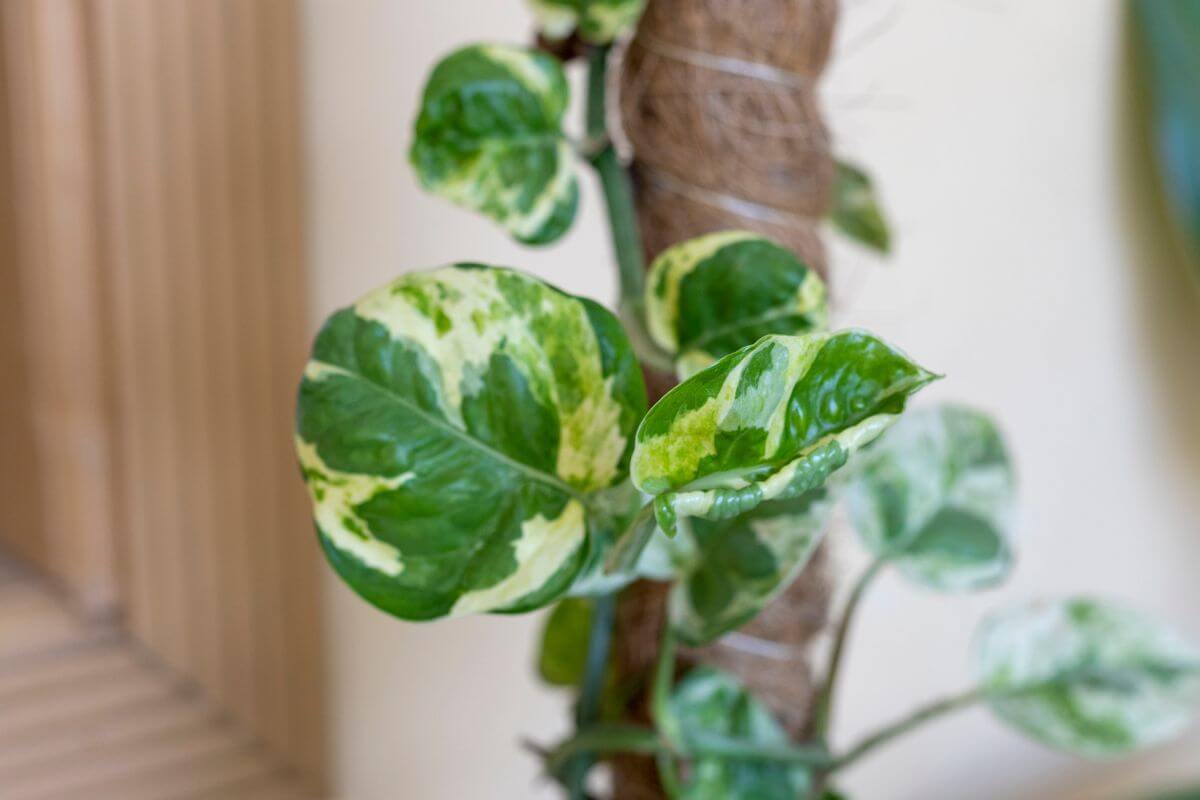
The first difference between the NJoy and Pearls and Jade is their leaf size. Both of these houseplants have smaller leaves, but not the same size.
The Pothos NJoy leaves can grow to five inches in size, while the leaves of the Pearls and Jade Pothos may grow no larger than two to three inches.
This may not be evident at first glance, but upon closer observation, leaf sizes can help you recognize one plant from the other.
Of course, the size of leaves will depend upon various environmental factors such as light, water, temperature, humidity, and growing medium.
A second differing characteristic feature is their leaf texture. The NJoy Pothos has thicker leaves that are glossy and leathery. The Pearls and Jade is thinner and will feel as if made from a quality paper.
The most distinctive feature between the two is the color variegation of the leaves.
The Pothos NJoy has a white background with several shades of green and is probably the only pothos cultivar that slightly resembles ivy, like the pothos’ popular name of Devil’s Ivy. When cultivated in low-light indoor conditions, the white may become yellow with green variegation.
Pearls and Jade, on the other hand, will feature a blend of white, green, and cream-colored variegation of leaves.
The N Joy will have smaller, oval-shaped, broader leaves with lots of variegation and will feature darker green stems or vines. The variegation will develop on a cream or white background and there will be more than one shade of green on each leaf. Green patches will differ in shape and size.
Leaf internodes will be short, and growth will tend to be fuller and compact. The texture of N Joy leaves will vary from top to underside as well. The tops of leaves will be smooth and waxy in appearance. The underside will feel more leathery.
Blooms
Both of these pothos plants will not flower when cultivated indoors. In its natural habitat, it can bloom when it reaches maturity.
Sheaths
Pothos are often confused with Philodendrons, but while a philodendron has a sheath that will partially envelop the stem for protection, the pothos does not. If you see a sheath, it’s not a pothos!
As philodendrons mature, sheaths grow larger, turn brown and papery in texture, The pothos does not necessitate this protection.
Growth
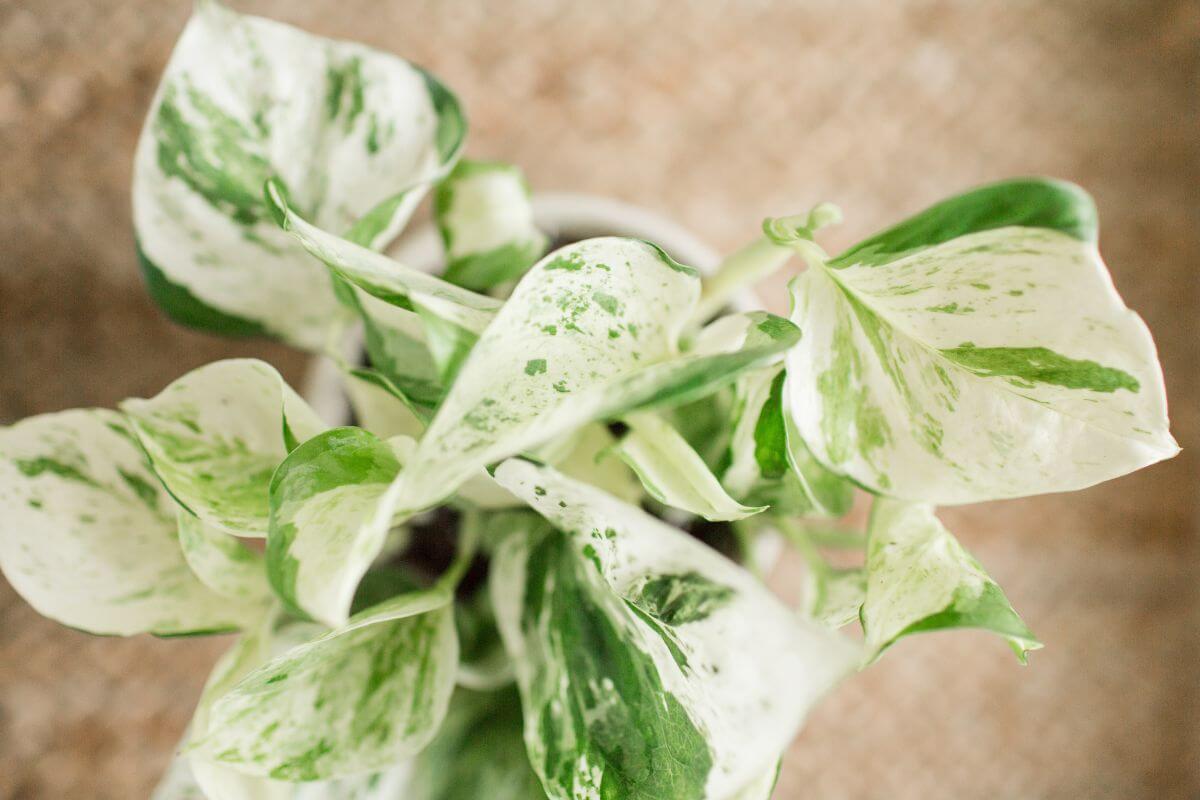
The Pothos NJoy and the Pearls and Jade are children plants of the Marble Queen Pothos. They are both considered to be slow growers.
Like all pothos cultivars, they are vining plants and can grow quite long. If you prefer a fuller, stand-up plant, you can prune the plant and shape it for compact growth.
The Pothos N Joy can grow to ten feet long depending on environmental conditions and the care received. It can be easily cultivated in a hanging basket or as a climbing plant on a pole or trellis.
It has a petiole of about two inches with a smooth texture. It can grow from six to ten inches tall with an outward spread of as much as 15 inches. Lateral branches can reach four inches long,
The Pearls and Jade Pothos is similar, but its petiole may grow from 7.5 to 8.5 inches and the larger leaves can grow from 2.5 to 3 inches in size. Leaf widths can grow from 1.5 to 2 inches wide.
NJoy vs Pearls and Jade Pothos Care
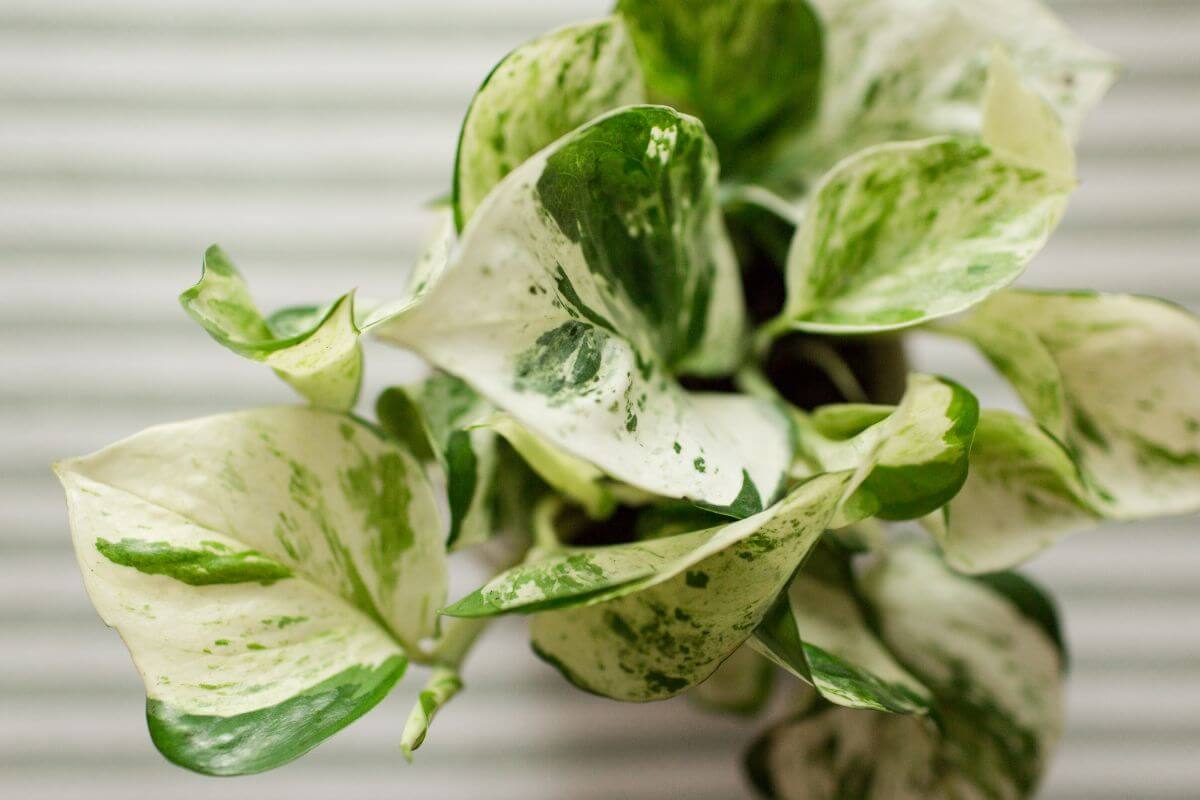
Soil Needs – NJoy vs Pearls and Jade
Both the NJoy Pothos and the Pearls and Jade Pothos have similar soil requirements. They both need loose, well-draining soil.
Two parts quality potting mix blended with one part perlite, Coco coir, or Orchid bark will make for a happy plant. Peat moss can be mixed in to improve drainage while retaining moisture.
Temperature Ranges – NJoy vs Pearls and Jade
The ideal temperature range for both of these pothos varieties is between 65° and 85° Fahrenheit. Avoid placing them near heating or air conditioning units or vents.
Lighting Needs – NJoy vs Pearls and Jade
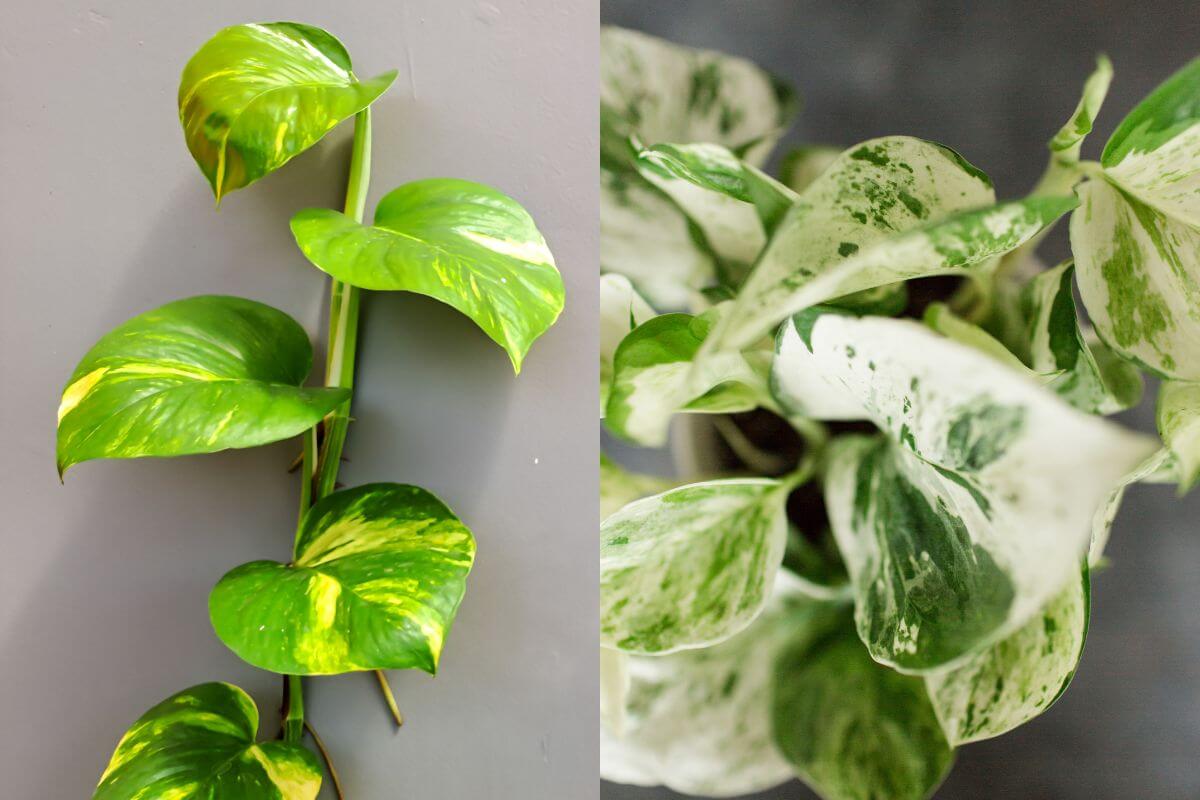
They can survive a whole range of lighting conditions, but good, balanced lighting will help maintain the variegation of the heart-shaped leaves.
Moderate to bright light that’s indirect is best for both plants. Direct sunlight will scorch the leaves.
Should either of these pothos plants develop whiter or pale leaves, they are receiving too much light.
If they become greener, they are receiving too little light. Place it in an area with more light when you see more solid green color on the leaves.
Watering Needs – NJoy vs Pearls and Jade
Both of these cultivars like higher moisture levels, but not to the point of overwatering. Overwater can be lethal to a pothos because it creates the conditions for root rot to set in.
When the top inch of the soil bed is dry, you can water the plant. Over-watered plants may show brown tips, yellow leaves, edemas, or wilting foliage.
Be sure that excess water drains out of the pot’s drainage holes when watering. Excess water that is trapped in the soil leads to soggy soil that will lead to root rot.
Humidity Needs – NJoy vs Pearls and Jade
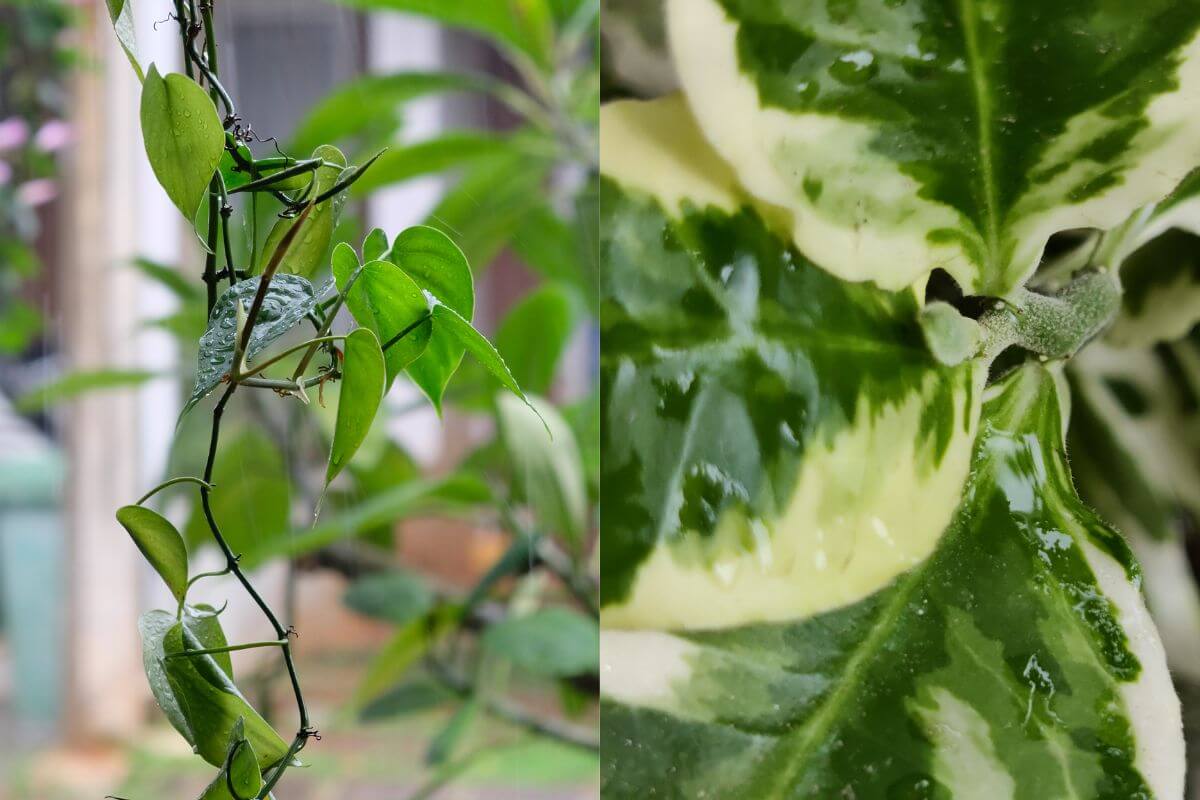
As cultivars of tropical plants, higher humidity levels are welcome. A humidity level that measures between 50 and 70% is optimal.
They are both good plants to place in the bathroom or kitchen as they are naturally humid areas.
Fertilizer Needs – NJoy vs Pearls and Jade
These pothos cultivars are light feeders, so they don’t require much fertilizer. They will still grow to be healthy plants without extra fertilizer feedings.
If you do want to fertilize, you can use a well-balanced houseplant fertilizer diluted to half-strength bi-monthly to encourage growth.
Repotting Needs – NJoy vs Pearls and Jade
If either cultivar becomes rootbound, it’s important to repot your plant into a pot that’s one size larger with fresh potting soil. The new pot should have a sufficient number of drainage holes.
Pruning Needs – NJoy vs Pearls and Jade
Pruning is necessary only if your pothos appears leggy to you, or if you wish to maintain it in the desired shape.
Should you decide that you would prefer a bushier, fuller-looking pothos, trim the stems until they are shorter. Remember to remove dead or dying foliage.
Propagation – NJoy vs Pearls and Jade
Both cultivars can be propagated easily with stem cuttings in water.
The propagation process is the same for both the NJoy and Pearls and Jade:
- Cut a length of vine four to six inches below a leaf node.
- Remove the lower leaves and place the cutting in a jar of water.
- The node should be submerged, but the leaves should always remain above the water.
- After approximately a month, roots should form. Change the water in the jar weekly while waiting for root growth.
- After roots have formed, you can now transplant them to fesh potting soil.
Houseplant Pests – NJoy vs Pearls and Jade
Common houseplant pests include aphids, mealybugs, scale insects, spider mites, and thrips among others. The majority of them will suck the sap out of the leaves.
If you see evidence of a pest infestation, remove scale and mealybugs manually, and then treat the plant with insecticidal soap or neem oil.
To remove other pests, give your plant a shower to wash the pests away. Then treat with insecticidal soap or neem oil.
Wiping leaves monthly with neem oil to remove dust will also help prevent pest infestations.
NJoy vs Pearls and Jade Final Thoughts
The NJoy Pothos and the Pearls and Jade Pothos are both lovely houseplants that require very little in the way of care. These vining plants can be propagated easily.
They have many similarities in terms of growth and care. But when it comes to their appearance, they have unique structures, leaf textures, and unique leaf variegations. Which is all the more reason to cultivate both in your home garden.
For more in-depth pothos guides, check these out:



